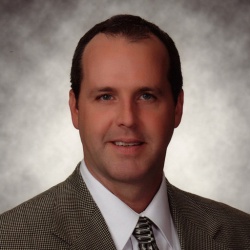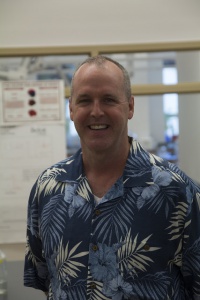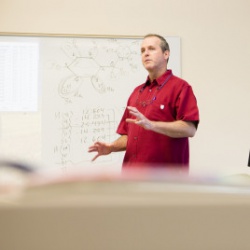Difference between revisions of "Bradley E Sturgeon"
| Line 60: | Line 60: | ||
::* Library Director 2018 (Henderson) | ::* Library Director 2018 (Henderson) | ||
::* Engineering 2019 (failed) | ::* Engineering 2019 (failed) | ||
| + | |||
| + | ==Service Beyond the College== | ||
| + | :- 2010-2019 - Coordinator for the IL-IA Local Section American Chemical Society (IL-IA ACS) Chemistry Olympiad Program. | ||
| + | :- 2019 - Chair-elect IL-IA ACS | ||
| + | :- 2020 - Chair IL-IA ACS | ||
| + | :- 2020 - External Review for Chemistry Program Clarke University | ||
| + | :- 2014 to present - [http://esr.monmsci.net/wiki/index.php/MACTLAC_Archives Archivist, MACTLAC] (Midwest Association of Chemistry Teachers in Liberal Arts Colleges) | ||
| + | :- 2017 Organizer of [http://esr.monmsci.net/wiki/index.php/MACTLAC_2017 65th Annual MACTLAC Meeting]. | ||
==EDUCATION== | ==EDUCATION== | ||
Revision as of 00:16, 7 November 2020
Monmouth College faculty Profile
BIO
Brad received a BS/MS in Chemistry from Illinois State University in 1987/1989 and a PhD in Physical Chemistry from the University of California, Davis in 1994. Brad was a postdoctoral fellow at Northwestern University, University of Chicago Medical Center, and the National Institute of Environmental Health Sciences/NIH. Brad's professional life has been spent in academia ranging from teaching at a residential science and math high school through major research university. Brad settled in to the small liberal arts college environment in 2007 by joining the faculty at Monmouth College. Brad currently teaches sections of General Chemistry and Physical Chemistry (Thermodynamics/Quantum Mechanics) and promotes a strong hands-on lab experience for chemistry and biochemistry students. Brad has studied the science underlying coffee, beer, and fireworks and has acquired a collection of "maker" tools including 3d printings (FDM/SLA), laser cutting/etching, and scientific glass blowing. Brad's research program includes the detection of enzyme-generated radical intermediates using ESR/EPR spectroscopy, detection/identification of radical-derived products using HPLC, and application of computational approaches to understanding electrostatic mapping of unpaired electrons in small organic radicals. Brad is married to his wife Katherine (since 1994) and has raised 2 adult children, both having attended fine liberal arts colleges (Monmouth and Luther).
Course Taught at Monmouth College
- - General Chemistry (Chem 140)
- 3, 50-min lectures/week/section
- When taught in the spring there is only 1 section of ~30-40 students).
- When taught in the fall there is usually 2 section (~50-60 students total).
- - General Chemistry Lab (Chem 140L)
- 3-hour lab/week
- When taught in the spring there are 2 lab sections.
- When taught in the fall there are 2 or 3 sections.
- - Physical Chemistry I with lab (Thermodynamics - Chem 312)
- 3, 50-min lecture + 4 hour/week lab
- Taught in the fall (~14-21 students)
- 3, 50-min lecture + 4 hour/week lab
- - Physical Chemistry II with lab (Quantum Mechanics - Chem 322)
- 3, 50-min lecture + 4 hour/week lab
- Taught in the spring (~9-14 students)
- 3, 50-min lecture + 4 hour/week lab
- - Science Seminar (Chem 350)
- Meets Friday 2-3 pm; I oversee ~ 8 talks by research students/semester
- - Research in Chemistry (Chem 430)
- Students register for a 4 or 8 hours/week research times; although new students require more time, on average I meet with them 1 hour/week.
- Usually have 8-12 research students.
- - Citizenship: Green Initiatives (INTG 402)
- 2, 90-min lecture/week.
- - Global Perspectives: Food (INTG 203)
- 2, 75-min lectures/week.
- - Academic Travel - Chemistry (Chem 290)
- Taught only once in J-term 2019; travelled to Forfar Field Station Andros Island, Bahamas.
Typical Fall semester
- - General Chemistry lab 2 or 3 sections or General Chemistry Lecture + 1 lab
- - Physical Chemistry I + lab
- - Science Seminar
- - Research in Chemistry
Typical Spring semester
- - General Chemistry lab 2 sections or General Chemistry Lecture + 2 labs
- - Physical Chemistry I + lab
- - Science Seminar
- - Research in Chemistry
Monmouth College Committee Service
- - 2008-2014 - Student Affairs Committee
- - 2014-2017 - Curriculum (Chair for 2 of these)
- - 2017-2020 - FIDC (Chair all 3 years)
- - 2011-2013 - Coordinator of Scholars Day Celebration
- - 2016 - Planning and Priorities Committee - Doing the Discipline
- - Faculty search Committees
- Organic Chemistry 2010 (Todd)
- Organic Chemistry 2013 (Forbes)
- Organic Chemistry 2015 (Prinsell)
- Neuroscience 2019 (Holle)
- Library Director 2018 (Henderson)
- Engineering 2019 (failed)
Service Beyond the College
- - 2010-2019 - Coordinator for the IL-IA Local Section American Chemical Society (IL-IA ACS) Chemistry Olympiad Program.
- - 2019 - Chair-elect IL-IA ACS
- - 2020 - Chair IL-IA ACS
- - 2020 - External Review for Chemistry Program Clarke University
- - 2014 to present - Archivist, MACTLAC (Midwest Association of Chemistry Teachers in Liberal Arts Colleges)
- - 2017 Organizer of 65th Annual MACTLAC Meeting.
EDUCATION
Ph.D., Physical Chemistry, September 1994. University of California, Davis; Davis, California, Dissertation: Electron Spin Echo Spectroscopy: Techniques and Applications to Manganese Systems. Advisor: Professor R. David Britt (rdbritt@ucdavis.edu).
M.S., Chemistry, May 1989. Illinois State University; Normal, Illinois, Thesis: Isotopic Perturbation and Its Effect on Isotopic Separation. Advisors: Professor Cheryl D. Stevenson (cdsteve@ilstu.edu) and Professor Richard C. Reiter (retired).
B.S., Chemistry, May 1987. Illinois State University; Normal, Illinois. Earned a bachelor's of science degree in chemistry (ACS approved). Participated in a Cooperative Education Program (CO-OP) with Nalco Chemical Company during junior and senior years. Conducted undergraduate research resulting in summer employment at Los Alamos National Laboratory (summer 1988, 1989).
TEACHING/RESEARCH EXPERIENCE
Associate Professor, Physical Chemistry, Monmouth College, 8/14-present Same as below.
Assistant Professor, Physical Chemistry, Monmouth College, 8/07-8/14. I teach and conduct independent research in the area of physical and biophysical chemistry. Course work includes: Thermodynamics and Kinetics (Physical Chem I), Quantum Mechanics (Physical Chem II), Physical Chemistry Laboratory, Computational Chemistry, Environmental Chemistry (non-majors), General Chemistry, and General Chemistry laboratory. Additionally, I teach, within the College’s Integrated Studies curriculum, a course on Citizenship related to green initiative and “water” and Global Initiatives related to food. My research program involves the direct detection of free radicals from enzymatic reactions. This program has both an experimental and computational approach. Techniques utilized include: Electron Spin Resonance (ESR), HPLC, electrochemical sensors (dioxygen, hydrogen peroxide, and nitric oxide), UV-Vis, and general lab techniques (buffers, solution prep, pH, compressed gases, etc). Computational efforts use a combination of DFT/B3YLP methods run through WebMO/Gaussian®.
Adjunct Faculty, Chemistry, Hood Collage and McDaniel College, 8/06-5/07. At Hood College I taught their “Discover Chemistry” general chemistry course. This laboratory-based, inquiry-based course is a where students spend three, 2-hour lab sessions per week exploring general chemistry principles traditionally taught in a lecture-style. At McDaniel College I taught Qualitative Analysis. This course has been previously taught in a very traditional fashion including a “glassware-based” laboratory. I was asked to modernize this course to include available instrumentation. The lab portion of the course was “presented” as a fictitious Contract Research Organization working in the “spirit of GLP.”
Assistant Professor, Physical Chemistry, Western Carolina University, 8/03-12/05. Taught and conducted independent research on enzyme biochemistry. Course work included: Thermodynamics and Kinetics (Physical Chem I), Quantum Mechanics (Physical Chem II), Chemical Dynamics Laboratory (Physical Chem Lab), Computational Chem (elective), general chem, and general chem laboratory. My research program involved the evaluation of enzyme and free radical chemistry. This biochemical research utilized: HPLC, electrochemical sensors for dioxygen, hydrogen peroxide, and nitric oxide, electron spin resonance, UV-Vis, and general lab techniques (buffers, solution prep, pH, compressed gases, etc). During the summers of ‘04 and ’05 I was the lead instructor for the NC Summer Ventures in Chemistry program. This 4 week, ~6 hrs per day program was directed at academically gifted high school students. My programs focused on enzyme biochemistry. The current dept. head is Prof. Cynthia Atterholt (atterholt@email.wcu.edu).
Visiting Lecturer, Analytical Chemistry, Univ. of North Carolina-Chapel Hill, 8/02-5/03. Taught Analytical Chemistry to science majors. The goal of this course was to introduce the fundamental concepts underlying analytical chemistry. There was a continuous emphasis on the “the analytical process”. This course covered the following topics: 1) acid/base chemistry, 2) analytical separations (general chromatography, GC, HPLC, capillary electrophoresis), 3) spectroscopy (UV-Vis spectroscopy), and 4) electrochemistry. Topics such as experimental error, statistics, and calibration were discussed in the context of the topics above. Course management was required due to the 200+ students enrolled. The current dept. head was Prof. James Jorgenson (jj@unc.edu).
Instructor, Chemistry, North Carolina School of Science and Math (NCSSM), 8/00-6/02. Taught chemistry to academically gifted junior and senior high school students accepted to this 10-month residential high school. The position responsibilities included: preparation of course and laboratory content, management of student records, and administrative responsibilities involving committee assignments, departmental meetings, grant preparation, and student discipline issues. The current dept. head is Myra Halpin, Ph.D. (halpin@ncssm.edu).
Chemist (GS-12/13, 1320), summers ‘01, ‘02, ‘03. National Institute of Environmental Health Sciences (NIEHS), Laboratory of Pharmacology and Chemistry, Research Triangle Park, NC. Advisors: Ronald P. Mason, Ph.D. (mason4@niehs.nih.gov) and Tom Burka, Ph.D. (bruka@niehs.nih.gov) This was summer employment during the years I taught. Projects related to IRTA at NIEHS/NIH immediately below.
Intramural Research Training Award (IRTA), 7/97 – 8/00. NIEHS, Laboratory of Pharmacology and Chemistry, Research Triangle Park, NC. Advisor: Ronald P. Mason, Ph.D. (mason4@niehs.nih.gov) Researched the role of free radical species involved in oxidative stress. Investigated the role of peroxidase enzymes in the formation of endogenous and exogenous substrate radicals. Directly detected free radicals using rapid-flow electron spin resonance (ESR) and indirectly using ESR spin trapping. Developed immobilized enzyme ESR method for enzymes that are not available in quantities necessary to perform rapid-flow measurements.
Post Doctoral Research Fellow, 1/96 - 6/97. University of Chicago Medical Center, Department of Radiation and Cellular Oncology. Advisor: Howard J. Halpern, Ph.D., M.D. (howard@rover.uchicago.edu) Projects involved biomedical research using a locally constructed 250 MHz Electron Spin Resonance (ESR) spectrometer. Investigated, in cellular systems, the role of anti-oxidant enzymes in the protection of cellular components from reactive oxygen species. Also used spin probes to determine in vivo oxygen concentration (oximetry) and viscosity, assisted in implementing multi-dimensional ESR imaging of tumors, and applied ESR spin trapping to reactive oxygen species.
Post Doctoral Research Fellow, 1/94 - 12/95. Northwestern University, Department of Chemistry, Evanston, IL. Advisor: Professor Brian M. Hoffman (bmh@northwestern.edu). Performed electron magnetic resonance studies on biological metalloenzymes, specifically carboxylate-bridged diiron centers. Used 35 GHz continuous wave (CW) Electron Paramagnetic Resonance (EPR)/Electron Nuclear Double Resonance (ENDOR) and 35 and 9 GHz pulsed EPR/ENDOR.
Graduate Research Assistant, 9/89 - 12/93. University of California, Davis, Department of Chemistry, Davis, CA. Advisor: Professor R. David Britt (rdbritt@ucdavis.edu). Conducted graduate research and course work focused on the biochemistry of protein structure and function. Constructed an 8-18 GHz pulsed Electron Spin Resonance/Electron Nuclear Double Resonance (EPR/ENDOR) spectrometer. Investigated a number of metalloenzyme systems using the pulsed EPR technique, most notably Electron Spin Echo Envelope Modulation (ESEEM) and Electron Spin Echo Electron Nuclear Double Resonance (ESE-ENDOR) of Mn(III)Mn(IV) model compounds, ESE-ENDOR of Mn(II), ESEEM/ESE-ENDOR of native and azide inhibited manganese catalase, and ESE-ENDOR of the oxygen evolving complex (OEC) of photosystem II (PSII).
Graduate Research Fellow, 6/88-8/88, 6/89-8/89. Los Alamos National Laboratory, Los Alamos, NM. Advisors: Paul Smith, Ph.D. (not available) and Wayne Smith, Ph.D. (wsmyth@lanl.gov). Conducted oxygen isotopic separations research in conjunction with the Isotope Separation Facility at LANL (INC-4). This facility has been since reorganized.
Graduate Research Assistant, 6/87 - 5/89. Illinois State University, Department of Chemistry, Normal, IL. Advisors: Professor Cheryl D. Stevenson (cdsteve@ilstu.edu) and Professor Richard C. Reiter (retired). Earned a Master's degree in physical organic chemistry. Conducted graduate research that resulted in summer employment at Los Alamos National Laboratory (summer 1989) and two scientific publications. Conducted physical organic research dealing with the separation of H, N, C, and O isotopes. Used vacuum line techniques to produce anion radicals of isotopically mixed organic compounds. EPR, FT-NMR, FT-IR, GC-Mass Spectral Analysis (GC-MS) techniques used in analysis of isotopic mixtures.
Publications
Partial listing...
Franzen, S.; Sasan, K.; Sturgeon, B. E.; Lyon, B. J.; Battenburg, B. J.; Dumariah, H. G. R.; and Ghiladi, R. Nonphotochemical Base-Catalyzed Hydroxylation of 2,6-Dichloroquinone by H2O2 Occurs by a Radical Mechanism. (2012) J. Phys. Chem. B, 116 (5), 1666–1676.
Sturgeon, B. E.; Battenburg, B. J.; Lyon, B. J.; Franzen, S. Revisiting the Peroxidase Oxidation of 2,4,6-Trihalophenols: ESR Detection of Radical Intermediates. (2011) Chem. Res. Toxicol., 24 (11), 1862–1868.
Connor, H. D.; Sturgeon, B. E.; Mottley, C.; Sipe, H. J. Jr.; Mason, R. P. L-Tryptophan Radical Cation Electron Spin Resonance Studies: Connecting Solution-derived Hyperfine Coupling Constants with Protein Spectral Interpretations. (2008) J. Am. Chem. Soc. 130, 6381-6387.
Sturgeon, B. E.; Chen, Y.-C.; Mason, R. P. Immobilized Enzyme Electron Spin Resonance: A Method for Detecting Enzymatically-Generated Transient Radicals. (2003) Anal. Chem. 75, 5006-5011.
Gunther M. R.; Sturgeon B. E.; Mason R. P. Nitric Oxide Trapping of the Tyrosyl Radical-Chemistry and Biochemistry. (2002) Toxicology 177, 1-9.
Chen, Y.-R.; Deterding, L. J.; Sturgeon, B. E.; Tomer, K. B.; Mason, R. P. Protein Oxidation of Cytochrome c by Reactive Halogen Species Enhances its Peroxidase Property. (2002) J. Biol. Chem. 277, 29781-27991.
Sturgeon, B. E.; Glover, R. E.; Chen, Y.-R.; Mason, R. P. Tyrosine Iminoxyl Radical Formation from Tyrosyl Radical/Nitric Oxide and Nitrosotyrosine. (2001) J. Biol. Chem. 276, 45516-45521.
Gunther, M. R.; Sturgeon, B. E.; Mason, R. P. A Long-Lived Tyrosyl Radical from the Reaction Between Metmyoglobin and Hydrogen Peroxide. (2000) Free Radic. Biol. Med. 28, 709-719.
Chen, Y-R.; Sturgeon, B. E.; Gunther, M. R.; Mason, R. P. ESR Investigation of the Cyanyl Radical in Cyanide/Cytochrome c Oxidase and Azidyl Radical in Azide/Cytochrome c Oxidase/H2O2 Systems. (1999) J. Biol. Chem. 274, 24611-24616.
Sturgeon, B. E.; Sipe, H. J. Jr.; Barr, D. P.; Corbett, J. T.; Martinez, J. G.; Mason, R. P. The Fate of the Oxidizing Tyrosyl Radical in the Presence of Glutathione and Ascorbate: Implication for the Radical Sink Hypothesis. (1998) J. Biol. Chem. 273, 30116-30121.
Sturgeon, B. E.; Burdi, D.; Chen, S. X.; Huynh, B. H.; Edmondson, D. E.; Stubbe, J.; Hoffman, B. M. Reconsideration of X, the Diiron Intermediate Formed During Cofactor Assembly in E. coli Ribonucleotide Reductase. (1996) J. Am. Chem. Soc. 118, 7551-7557.
Sturgeon, B. E.; Britt, R. D. Sensitive Pulsed EPR Spectrometer with an 8-18 GHz Frequency Range. (1992) Rev. Sci. Instrum. 63, 2187-2192.


